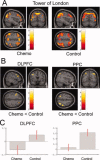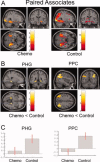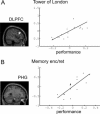Cerebral hyporesponsiveness and cognitive impairment 10 years after chemotherapy for breast cancer
- PMID: 20669165
- PMCID: PMC6869999
- DOI: 10.1002/hbm.21102
Cerebral hyporesponsiveness and cognitive impairment 10 years after chemotherapy for breast cancer
Abstract
Chemotherapy is associated with cognitive impairment in a subgroup of breast cancer survivors, but the neural circuitry underlying this side effect is largely unknown. Moreover, long-term impairment has not been studied well. In the present study, functional magnetic resonance imaging (fMRI) and neuropsychological testing were performed in breast cancer survivors almost 10 years after high-dose adjuvant chemotherapy (chemo group, n = 19) and in breast cancer survivors for whom chemotherapy had not been indicated (control group, n = 15). BOLD activation and performance were measured during an executive function task involving planning abilities (Tower of London) and a paired associates task for assessment of episodic memory. For the chemo group versus the control group, we found hyporesponsiveness of dorsolateral prefrontal cortex in the Tower of London, and of parahippocampal gyrus in the paired associates task. Also, the chemo group showed significantly impaired planning performance and borderline significantly impaired recognition memory as compared to findings in the control group. Whole-brain analyses demonstrated hyporesponsiveness of the chemo versus the control group in very similar regions of bilateral posterior parietal cortex during both the Tower of London and the paired associates task. Neuropsychological testing showed a relatively stable pattern of cognitive impairment in the chemo group over time. These results indicate that high-dose adjuvant chemotherapy is associated with long-term cognitive impairments. These impairments are underpinned by (a) task-specific hyporesponsiveness of dorsolateral prefrontal cortex and parahippocampal gyrus, and (b) a generalized hyporesponsiveness of lateral posterior parietal cortex encompassing attentional processing.
Copyright © 2010 Wiley-Liss, Inc.
Figures





Similar articles
-
Reduced prefrontal activation during working and long-term memory tasks and impaired patient-reported cognition among cancer survivors postchemotherapy compared with healthy controls.Cancer. 2016 Jan 15;122(2):258-68. doi: 10.1002/cncr.29737. Epub 2015 Oct 20. Cancer. 2016. PMID: 26484435 Free PMC article.
-
Very Late Treatment-Related Alterations in Brain Function of Breast Cancer Survivors.J Int Neuropsychol Soc. 2015 Jan;21(1):50-61. doi: 10.1017/S1355617714001015. Epub 2014 Dec 22. J Int Neuropsychol Soc. 2015. PMID: 25529014 Clinical Trial.
-
Executive Function Alternations of Breast Cancer Patients After Chemotherapy: Evidence From Resting-state Functional MRI.Acad Radiol. 2016 Oct;23(10):1264-70. doi: 10.1016/j.acra.2016.05.014. Epub 2016 Jun 23. Acad Radiol. 2016. PMID: 27346235
-
Cognitive impairment in breast cancer survivors treated with chemotherapy depends on control group type and cognitive domains assessed: A multilevel meta-analysis.Neurosci Biobehav Rev. 2017 Dec;83:417-428. doi: 10.1016/j.neubiorev.2017.10.028. Epub 2017 Oct 29. Neurosci Biobehav Rev. 2017. PMID: 29092778 Review.
-
Functional MRI studies in non-CNS cancers.Brain Imaging Behav. 2013 Dec;7(4):388-408. doi: 10.1007/s11682-013-9249-9. Brain Imaging Behav. 2013. PMID: 23934234 Review.
Cited by
-
Effect of cancer therapy on neural stem cells: implications for cognitive function.Curr Opin Oncol. 2012 Nov;24(6):672-8. doi: 10.1097/CCO.0b013e3283571a8e. Curr Opin Oncol. 2012. PMID: 22913969 Free PMC article. Review.
-
Quantifying cognitive decrements caused by cranial radiotherapy.J Vis Exp. 2011 Oct 18;(56):3108. doi: 10.3791/3108. J Vis Exp. 2011. PMID: 22042060 Free PMC article.
-
A problem-solving task specialized for functional neuroimaging: validation of the Scarborough adaptation of the Tower of London (S-TOL) using near-infrared spectroscopy.Front Hum Neurosci. 2014 Mar 28;8:185. doi: 10.3389/fnhum.2014.00185. eCollection 2014. Front Hum Neurosci. 2014. PMID: 24734017 Free PMC article.
-
Associations between catecholaminergic, GABAergic, and serotonergic genes and self-reported attentional function in oncology patients and their family caregivers.Eur J Oncol Nurs. 2015 Jun;19(3):251-9. doi: 10.1016/j.ejon.2014.11.004. Epub 2014 Dec 15. Eur J Oncol Nurs. 2015. PMID: 25524657 Free PMC article.
-
Work status changes and associated factors in a nationwide sample of Norwegian long-term breast cancer survivors.J Cancer Surviv. 2024 Apr;18(2):375-384. doi: 10.1007/s11764-022-01202-2. Epub 2022 Mar 22. J Cancer Surviv. 2024. PMID: 35314959 Free PMC article.
References
-
- Aaronson NK, Ahmedzai S, Bergman B, Bullinger M, Cull A, Duez NJ, Filiberti A, Flechtner H, Fleishman SB, de Haes JC ( 1993): The European organization for research and treatment of cancer QLQ‐C30: A quality‐of‐life instrument for use in international clinical trials in oncology. J Natl Cancer Inst 85: 365–376. - PubMed
-
- Ahles TA, Saykin AJ ( 2001): Cognitive effects of standard‐dose chemotherapy in patients with cancer. Cancer Invest 19: 812–820. - PubMed
-
- Alpherts W, Aldenkamp AP. 1994. FePsy: The Iron Psyche. Heemstede: Instituut voor Epilepsiebestrijding.
-
- Cabeza R, Nyberg L ( 2000): Imaging cognition II: An empirical review of 275 PET and fMRI studies. J Cogn Neurosci 12: 1–47. - PubMed
MeSH terms
Substances
LinkOut - more resources
Full Text Sources
Medical

